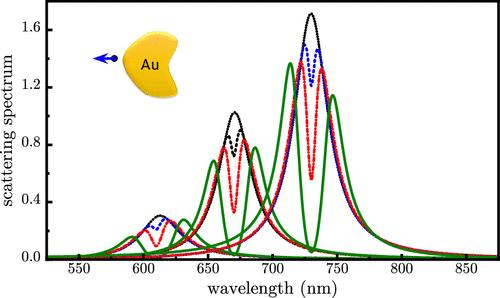强激子-等离子体耦合的非洛伦兹模型
IF 3.2
3区 化学
Q2 CHEMISTRY, PHYSICAL
引用次数: 0
摘要
我们建立了金属介电结构中量子发射体(QEs)与局域表面等离子体(LSPs)共振耦合的非洛伦兹分析模型。利用LSP格林函数的显式形式,我们推导了半经典麦克斯韦-布洛赫方程的非洛伦兹版本,该方程直接用金属复介电函数而不是洛伦兹共振来描述LSP。对于单个QE谐振耦合到LSP的混合系统,我们得到了有效偏振率的解析表达式,该表达式在洛伦兹近似下恢复了经典耦合振子模型的结果。我们证明了由金属介电函数的时间色散引起的非洛伦兹效应在混合系统过渡到强耦合状态时对光谱有显著影响。具体而言,与Lorentzian模型的结果相比,系统散射光谱中的主要谱权向低能极化带偏移,与实验结果一致。本文章由计算机程序翻译,如有差异,请以英文原文为准。

A Non-Lorentzian Model for Strong Exciton–Plasmon Coupling
We develop a non-Lorentzian analytical model for quantum emitters (QEs) resonantly coupled to localized surface plasmons (LSPs) in metal–dielectric structures. Using the explicit form of the LSP Green function, we derive non-Lorentzian version of semi-classical Maxwell–Bloch equations that describe LSPs directly in terms of metal complex dielectric function rather than via Lorentzian resonances. For a single QE resonantly coupled to an LSP, we obtain an analytical expression for effective optical polarizability of the hybrid system, which, in the Lorentzian approximation, recovers the results of the classical coupled oscillators model. We demonstrate that non-Lorentzian effects originating from temporal dispersion of the metal dielectric function affect significantly the optical spectra as the hybrid system transitions to the strong coupling regime. Specifically, in contrast to results of Lorentzian models, the main spectral weight in the system scattering spectra is shifted toward the lower energy polaritonic band, consistent with the experiment.
求助全文
通过发布文献求助,成功后即可免费获取论文全文。
去求助
来源期刊

The Journal of Physical Chemistry C
化学-材料科学:综合
CiteScore
6.50
自引率
8.10%
发文量
2047
审稿时长
1.8 months
期刊介绍:
The Journal of Physical Chemistry A/B/C is devoted to reporting new and original experimental and theoretical basic research of interest to physical chemists, biophysical chemists, and chemical physicists.
 求助内容:
求助内容: 应助结果提醒方式:
应助结果提醒方式:


